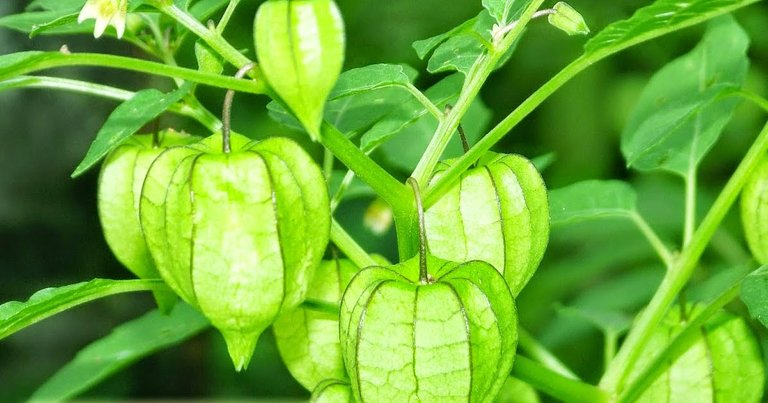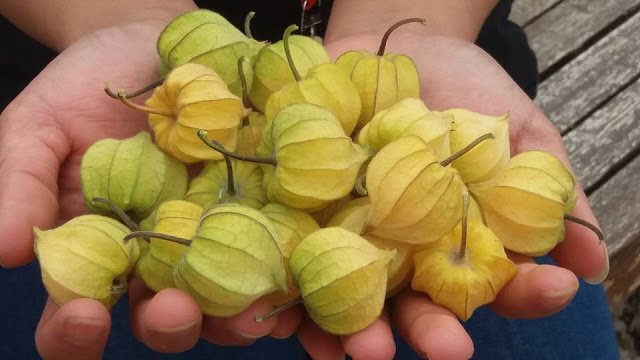

- Name of Plant
Scientific Name: Physalis angulata L.
Local names: Morel berry, Ciplukan (Java), Cecendet (Sunda), Yor-yoran (Madura), Lapinonat (Seram), Questionnaires, Curves, Teplokan (Bali), Dedes (Sasak) Lamanet (Minahasa).
Classification of Plant
Kingdom: Plantae
Division: Spermatophyta
Sub division: Angiospermae
Class: Dicotyledonnae
Order: Solanales
Family: Solanaceae
Marga: Physalis
Species: Physalis angulata L.Description Plant
Physalis angulat a L. is hual plants anual (annual) with a height of 0.1-1 m. The main stem is unclear, branching rounds, sharp-edged, ribbed, hollow, green-haired or bare-bald. The leaves are single, stemmed, the bottom is scattered, on top in pairs, the shapes are round-shaped rounded round with a pointed tip, the flat is not the same (tapered-blunt-rounded-tapered), flat-brimmed or Wavy-toothed, 5-15 x 2.5-10.5 cm.
Single flower, on the tip or armpit of the leaf, symmetry of many, upright flower stalk with nodding tip, trim, violet, 8-23 mm, then grow to 3 cm. Petal-shaped petals, 5 pointed lobes, share, green with violet ribs. The crown is a wide bell, High 6-10 mm, bright yellow with brown yellow stains, under each stain is a grouping of short V-shaped hairs. The yellow pale yarn stalks, the sari head is entirely light blue. Baldness shaved, button-shaped pistil head, fruit will 2 fruit leaves, many will be seeds. Egg-shaped ciplukan fruit, up to 14 mm long, green to yellow if ripe, veined, has petals.
4.Habitat, Spreading, and Cultivation
Ciplukan are native American plants that are now widely spread in the tropics of the world. In Java it grows wild in gardens, moor, curbs, gardens, shrubs, light forest, forest edges. Ciplukan usually grows in areas with a height between 1-1550 m above sea level. Shoot cultures can grow well on MS medium with the addition of BA and IAA growth regulators. The rate and comparison of growth regulators for the regeneration of shoot cultures to obtain plant BA 3-4 ppm and IAA 0.1 ppm
Use in the community
Roots of plants ciplukan generally used as a worm and fever-lowering drugs. The leaves are used for healing broken bones, water drops, boils, ulcers, heart reinforcement, sprains, abdominal pain, and gonorrhea. Ciplukan fruit itself is often eaten; To treat epilepsy, can not urinate, and jaundice.Chemical Content
The active compounds contained in ciplukan include saponins, flavonoids, polyphenols, and fisalin. Composition details on some parts of the plant, among others:
A. Herba: Fisalin B, Physalin D, Physalin F, Withangulatin A
B. Seeds: 12-25% protein, 15-40% fat oil with main components of palmitic acid and stearic acid.
C. Root: alkaloids
D. Leaves: flavonoid glycosides (luteolin)
E. Shoots: flavonoids and saponins
7.Perkembangan P. angulata research
Since long, ciplukan has been examined by experts from various countries. Such research usually focuses on activities owned by ciplukan. From the research that has been done, both in vitro and in vivo, obtained information that ciplukan have activities as antihiperglikemi, antibacterial, antiviral, immunostimulant and immunosuppressant (immunomodulator), antiinflamasi, antioxidant, and cytotoxic.
Baedowi [1998] has done research on ciplukan in vivo in mice. From the research, it was found that the extract of leaves of ciplukan with a dose of 28.5 mL / kg body weight can affect pancreatic β cells. This indicates the presence of antihyperglycemic activity of ciplukan.
Januario et al. (2000) has tested the antimicrobial activity of pure herbal extract Physalis angulata L. The fraction A1-29-12 consisting of FATALAL B, D, and FACT KHM (Minimum Inhibitory Level) inhibiting Mycobacterium tubercolosis H37Rv of 32 μg.mL-1 . Physical B and Dressed KHM values in inhibiting Mycobacterium tubercolosis H37Rv of> 128 μg.mL-1 and 32 μg.mL-1 respectively. It is suspected that Physalin D plays an important role in the antimicrobial activity shown. The fractions of A1-29-12 consisting of the Phalum B, D, and F indicate KHM (Minimum Inhibitory) inhibiting Mycobacterium tubercolosis H37Rv of 32 μg.mL-1. Physical B and Dressed KHM values in inhibiting Mycobacterium tubercolosis H37Rv of> 128 μg.mL-1 and 32 μg.mL-1 respectively. It is suspected that Physalin D plays an important role in the antimicrobial activity shown. The fractions of A1-29-12 consisting of the Phalum B, D, and F indicate KHM (Minimum Inhibitory) inhibiting Mycobacterium tubercolosis H37Rv of 32 μg.mL-1. Physical B and Dressed KHM values in inhibiting Mycobacterium tubercolosis H37Rv of> 128 μg.mL-1 and 32 μg.mL-1 respectively. It is suspected that Physalin D plays an important role in the antimicrobial activity shown.
Bibliography
Baedowi, 1998, Glycogen Deposits in Hepatocytes and Beta Cell Activity Insula Pancreatisi Rat White (Rattus norvegicus) Due to the Giving of Ciplukan Leaf Extracts, Drug Research on Some Union